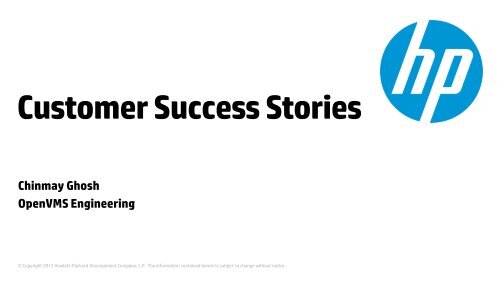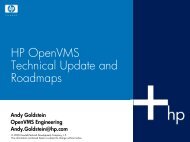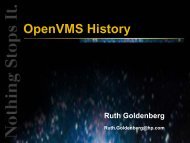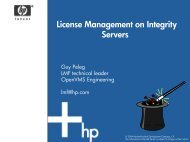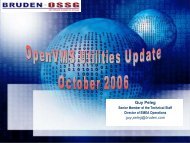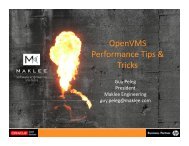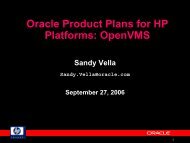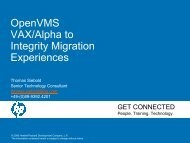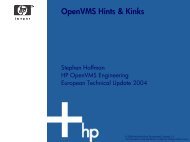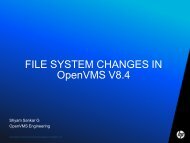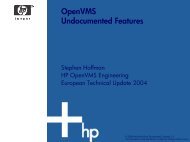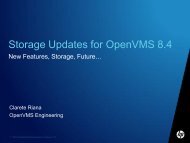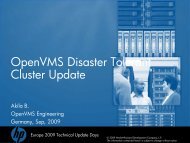OpenVMS Success Story - Woertman
OpenVMS Success Story - Woertman
OpenVMS Success Story - Woertman
You also want an ePaper? Increase the reach of your titles
YUMPU automatically turns print PDFs into web optimized ePapers that Google loves.
Customer <strong>Success</strong> Stories<br />
Chinmay Ghosh<br />
<strong>OpenVMS</strong> Engineering<br />
© Copyright 2012 Hewlett-Packard Development Company, L.P. The information contained herein is subject to change without notice.
Agenda<br />
• Existing setups<br />
• Issues during migration<br />
• Issues post migration<br />
• Performance comparison and tuning<br />
• Key takeaways<br />
• Revisit top 10 porting considerations<br />
• Customer Lab<br />
2<br />
© Copyright 2012 Hewlett-Packard Development Company, L.P. The information contained herein is subject to change without notice.
Customer 1<br />
• Large telecom customer<br />
• <strong>OpenVMS</strong> is used for billing application<br />
• Mission critical<br />
3<br />
© Copyright 2012 Hewlett-Packard Development Company, L.P. The information contained herein is subject to change without notice.
Customer 1- Existing and proposed setups<br />
Existing Environment<br />
860 860<br />
• Production : 2 x Alpha ES80<br />
ES80 ES80<br />
c i2 c i2<br />
• EVA8000 SAN storage<br />
• DR : same as production<br />
Migrated Environment<br />
• Production : 2 x BL860c i2<br />
• EVA8000 SAN storage<br />
Shadow Sets<br />
• DR : same as production<br />
Software<br />
COBOL, Fortran, C, ACMS, DECforms, Oracle Rdb, Oracle CDD etc<br />
ES80<br />
EVA 8000 EVA 8000<br />
ES80<br />
4<br />
© Copyright 2012 Hewlett-Packard Development Company, L.P. The information contained herein is subject to change without notice.
Issues faced during migration<br />
SLS not available in I64<br />
− Used ABS<br />
COBOL keywords used in source modules(SYMBOL, RETURN-CODE)<br />
− Recompiled with “/NOXOPEN” and “/RESER=NO200X/SWITCH=DC_NO_SYMBOL”.<br />
Floating points<br />
− Recompiled entire code with D_FLOAT<br />
Conditionalized code using __ALPHA<br />
− Modified and added “|| __IA64”<br />
COBOL MOVE CORRESPONDING issue<br />
− Modified source code to have proper data type<br />
%ILINK-E-INVOVRINI, incompatible multiple initializations for overlaid section<br />
− initialize the database handles in only one of the modules<br />
− Use /NOINITIALIZE_HANDLES with other SQLMOD/precompiler modules<br />
5<br />
© Copyright 2012 Hewlett-Packard Development Company, L.P. The information contained herein is subject to change without notice.
Issues faced post migration<br />
Test Alpha Integrity<br />
RMS random write 4:72 2:35<br />
Rdb random read 8:50 18:54<br />
Alignment faults = ~500,000/Second<br />
Asked to provide FLT trace<br />
6<br />
© Copyright 2012 Hewlett-Packard Development Company, L.P. The information contained herein is subject to change without notice.
Issues faced post migration ‟ Analysis and Resolution<br />
• Alignment faults were from COBOL initialize statement and LIBRTL<br />
− Resolved in latest releases of COBOL compiler<br />
− Provided a new LIBRTL imaged by removing alignment faults<br />
• Performance comparison after removal of alignment faults<br />
>40%<br />
Improvement<br />
Time<br />
Elapsed time (I64)<br />
Elapsed time(Alpha)<br />
• Improvement = >40% RMS Rdb random read<br />
7<br />
© Copyright 2012 Hewlett-Packard Development Company, L.P. The information contained herein is subject to change without notice.
Key takeaways<br />
• Take a complete inventory of application stack before porting<br />
• Identify hardware dependent codes<br />
• Use of latest COBOL compiler on Alpha would have reduced porting effort<br />
• Very little modifications in source code<br />
• Alignments faults are very costly on I64<br />
• Need to have test tool to validate performance<br />
• i2 servers can deliver far better performance<br />
8<br />
© Copyright 2012 Hewlett-Packard Development Company, L.P. The information contained herein is subject to change without notice.
Customer 2<br />
• Provides travel solution<br />
• Performance is very critical<br />
9<br />
© Copyright 2012 Hewlett-Packard Development Company, L.P. The information contained herein is subject to change without notice.
Customer 2 ‟ Existing and proposed setups<br />
• Existing Environment<br />
− System : Alpha ES40, 2 CPU<br />
• Migrated Environment<br />
− System : HP rx3600 (1.60GHz/6.0MB), 2 CPU<br />
• Local storage<br />
• Application language – BASIC<br />
• Issue : Application execution duration on I64 > 4 times compared to Alpha<br />
10<br />
© Copyright 2012 Hewlett-Packard Development Company, L.P. The information contained herein is subject to change without notice.
Performance analysis<br />
• T4 data<br />
− No apparent issue. MPSYNC very minimal<br />
• PRF data<br />
− 42.62% time in LIBRTL<br />
− 14.55% time in EXCEPTION<br />
• EXC trace<br />
− Most of the LIBRTL calls were to stack unwinding routines<br />
− Resulted from RMS-E- RECNOTFOUND<br />
11<br />
© Copyright 2012 Hewlett-Packard Development Company, L.P. The information contained herein is subject to change without notice.
Analysis contd..<br />
• Encountered exception in $GET when the record is not present<br />
− Signaled with exception code RECNOTFOUND from BASRTL while using GET & FIND<br />
‣Resulted in exception handling and stack unwinding<br />
• Resolution<br />
− Modified BASRTL to return error RMS$_EOF instead of signaling<br />
− BASIC application can be modified with<br />
nosigconds%(1) = RMS$_RNF ! implicit integer array<br />
call dbasic$io_no_signal(chan%, nosigconds%())<br />
− Introduced logical DBASIC$IO_NOSIGNAL (No source code modification)<br />
• Results<br />
− Sample application showed 10 times improvement<br />
12<br />
© Copyright 2012 Hewlett-Packard Development Company, L.P. The information contained herein is subject to change without notice.
Key takeaways<br />
• SDA extensions (PRF,EXC, FLT etc..) are very useful<br />
• May need to use different monitoring tools<br />
• EXCEPTION handling and stack unwinding are very costly on Integrity<br />
−<br />
Instead of signaling returning the error helps<br />
• Need to have test tool to validate performance<br />
13<br />
© Copyright 2012 Hewlett-Packard Development Company, L.P. The information contained herein is subject to change without notice.
Customer 3<br />
• Provides telecom service<br />
• Mission critical<br />
• Performance is critical<br />
14<br />
© Copyright 2012 Hewlett-Packard Development Company, L.P. The information contained herein is subject to change without notice.
Customer 3 ‟ Existing and proposed setups<br />
• Existing Environment :<br />
− Production : AlphaServer ES40 (4GB with 2 cpu(s))<br />
• Migrated Environment :<br />
− Production : BL860c i2, <strong>OpenVMS</strong> 8.4<br />
• Storage :<br />
− EVA8400<br />
• Software :<br />
COBOL, PASCAL, Fortran, C, ACMS, DECforms, Tuxedo, Oracle Rdb, Oracle CDD,XML-C etc.<br />
15<br />
© Copyright 2012 Hewlett-Packard Development Company, L.P. The information contained herein is subject to change without notice.
Issues faced during migration<br />
• DEC ECP not available<br />
− Advised to use TDC<br />
•Tuxedo startup error %LIB-E-INSVIRMEM<br />
− Readjusted <strong>OpenVMS</strong> SYSGEN, quota and Tuxedo parameters<br />
• Issues related to floating points<br />
− Suggested to use either IEEE or G_FLOAT uniformly<br />
• Issue with old compiler while using “/pointer=long=argv”<br />
− Resolved using latest compilers<br />
16<br />
© Copyright 2012 Hewlett-Packard Development Company, L.P. The information contained herein is subject to change without notice.
Issues faced post migration<br />
• Tuxedo thread running at real-time priority 63<br />
− Known problem with Tuxedo. Oracle has a patch.<br />
• Performance issue with Oracle Rdb<br />
− Installed latest version of Rdb<br />
− Consulted Rdb support team<br />
17<br />
© Copyright 2012 Hewlett-Packard Development Company, L.P. The information contained herein is subject to change without notice.
Rdb performance Issue (1/4)<br />
Problem Statement<br />
„ Customer observed poor performance while executing SQL queries on I64<br />
Alpha, Local DB I64, Local DB Alpha, DB on remote I64<br />
10 Sec. 24 Sec. 18 Sec.<br />
Analysis<br />
„ Only batch jobs were taking more time. Interactive jobs were executing much faster.<br />
Suggestion<br />
„ Customer was asked to provide the location of the batch job log files.<br />
„ Asked to relocate the log files if they are in the system disk.<br />
18<br />
© Copyright 2012 Hewlett-Packard Development Company, L.P. The information contained herein is subject to change without notice.
Rdb performance issues (2/4)<br />
Problem Statement<br />
„ After relocating the log files from system disk customer observed better performance on I64. Expectation<br />
was better performance for I64 where database on remote Alpha.<br />
Alpha, Local DB I64, Local DB Alpha, DB on remote I64 Alpha, DB on remote<br />
Alpha<br />
10 Sec. 3 Sec. 13 Sec. 13 Sec.<br />
Analysis<br />
„ Since I64 local query takes ~3 Sec. customer was expecting ~7 sec for remote queries.<br />
„ Customer was executing ROLLBACK after every SELECT query<br />
Suggestion<br />
„ Customer was asked to provide T4 data<br />
„ Asked to reduce the number of ROLLBACK calls.<br />
„ Asked to tune RDB$REMOTE_BUFFER_SIZE or SQL_NETWORK_BUFFER_SIZE<br />
„ Asked to keep .RDB and .RDA files on different disk<br />
19<br />
© Copyright 2012 Hewlett-Packard Development Company, L.P. The information contained herein is subject to change without notice.
Rdb performance issues (3/4)<br />
Problem Statement<br />
„ After increasing buffer sizes customer saw improvement in remote execution, but still not up to the<br />
expectation.<br />
I64, Local DB Alpha, Local DB Alpha, DB on remote I64 Alpha, DB on remote Alpha<br />
3 Sec. 10 Sec. 11.5 Sec. 13 Sec.<br />
Analysis<br />
„ Customer didn’t implement the other suggestion to reduce the number of ROLLBAK calls.<br />
„ T4 data didn’t show any specific problem with the system<br />
Suggestion<br />
„ Customer was asked again to reduce the number of ROLLBACKS<br />
20<br />
© Copyright 2012 Hewlett-Packard Development Company, L.P. The information contained herein is subject to change without notice.
Rdb performance issues (4/4)<br />
Final result<br />
„ customer received much improved performance once he reduced the number of calls to<br />
ROLLBACK to 1 for every 15 SELECT queries.<br />
I64, Local DB Alpha, Local DB Alpha, DB on<br />
remote I64<br />
Alpha, DB on<br />
remote Alpha<br />
3 Sec. 10Sec. 8.7 Sec. 13 Sec.<br />
21<br />
© Copyright 2012 Hewlett-Packard Development Company, L.P. The information contained herein is subject to change without notice.
Key takeaways<br />
• Take a complete inventory of application stack before porting<br />
• Adjusting SYSGEN parameters may be required<br />
• Need to use several performance monitoring tool<br />
• Need to have test tool to validate performance<br />
• Try to keep the log files away from the system disk<br />
22<br />
© Copyright 2012 Hewlett-Packard Development Company, L.P. The information contained herein is subject to change without notice.
Customer 4<br />
• Telecom solution provider<br />
• Performance is very critical<br />
23<br />
© Copyright 2012 Hewlett-Packard Development Company, L.P. The information contained herein is subject to change without notice.
Customer 4 ‟ Existing and proposed setup<br />
• Existing Environment : HP BL860c (1.59GHz/12MB, 4 CPUs)<br />
• Migrated Environment : HP BL860c i2 (1.73GHz/24MB, 8 CPUs)<br />
in c7000 enclosure<br />
• Storage : EVA4400<br />
• ISV delivers the following configurations<br />
−<br />
−<br />
−<br />
Low end: RX2660 with MSA60<br />
Medium: Dual node RX2660 with MSA60 or EVA4400, BL860c with EVA4400<br />
High end: 3 to 16 nodes BL860c cluster with EVA4400 up to EVA8400<br />
24<br />
© Copyright 2012 Hewlett-Packard Development Company, L.P. The information contained herein is subject to change without notice.
Analysis on BL860c(4 CPUs)<br />
• MP sync time was considerably higher.<br />
• The major contention for SCHED and LCKMGR spinlocks<br />
• SCHED was taken for AST queuing, hibernate, event flag posting and resched interrupt<br />
‟ Deferred SCHED was considered to be a good option for this customer<br />
• Around 20 processes in the COM queue<br />
• Indicates that more processes are waiting for CPU. Suggested increasing the CPUs<br />
• Heavy local lock operations<br />
• Suggested dedicated lock manager if number of CPUs more than 4<br />
• <strong>OpenVMS</strong> executive not responsible for excessive CPU usage<br />
• Suggested more CPUs to improve performance<br />
• Hyper threading result was not encouraging<br />
• Pointed out user processes running in the kernel mode and consuming the most CPU time<br />
25<br />
© Copyright 2012 Hewlett-Packard Development Company, L.P. The information contained herein is subject to change without notice.
Comparison of performance on a clustered BL860c(4<br />
CPUs) & standalone BL860c i2<br />
• Good amount of improvement (almost<br />
double) in user mode time in BL860C i2<br />
(from 168/400 to 400/800).<br />
• Slight reduction in kernel mode time and<br />
interrupt time, thereby providing more CPU<br />
time for application.<br />
• During peak load 8 processes in “CUR”<br />
state - indicates that the increase in the<br />
number of CPUs is helping the application.<br />
•Increase in the logical name translations<br />
which is almost doubled.<br />
Resource<br />
Utilization<br />
Time spent in each<br />
mode<br />
Clustered<br />
BL860c<br />
(4 CPUs)<br />
40% kernel<br />
42% user<br />
11% interrupt<br />
2% MP synch<br />
Standalone BL860c i2<br />
(8 CPUs)<br />
36% kernel<br />
50% user<br />
2% interrupt<br />
9% MP synch<br />
Cur/COM state 4/20 8/20<br />
Lock Conversions 70,000 70,000<br />
Locks in total 46,000 86,000<br />
TQE 385 485<br />
Logical Name<br />
Translations<br />
2,200 4,200<br />
26<br />
© Copyright 2012 Hewlett-Packard Development Company, L.P. The information contained herein is subject to change without notice.
Comparison of performance on a clustered BL860c(4<br />
CPUs) & clustered BL860c i2<br />
•Noticeable amount of change when the<br />
node is in cluster environment.<br />
• Major increase in MP synch time from 9%<br />
to 14.5%.<br />
•Decline in user mode time.<br />
•Increase in Buffered I/O rate.<br />
•Suggested to enable dedicated lock<br />
manager in order to control the MP sync.<br />
Resource<br />
Utilization<br />
Time spent in<br />
each mode<br />
Buffered I/O<br />
rate<br />
Lock<br />
Conversions<br />
Clustered<br />
BL860c<br />
(4 CPUs)<br />
40% kernel<br />
42% user<br />
11% interrupt<br />
2% MP synch<br />
Standalone<br />
BL860c i2<br />
(8 CPUs)<br />
36% kernel<br />
50% user<br />
2% interrupt<br />
9% MP synch<br />
Clustered BL860c<br />
i2<br />
(8 CPUs)<br />
37% kernel<br />
34%user<br />
6.5% interrupt<br />
14.5% MP sync<br />
17,500 5,000 24,000<br />
70,000 70,000 56,000<br />
Locks in total 46,000 86,000 86,000<br />
TQE 385 485 520<br />
Logical Name<br />
Translations<br />
2,200 4,200 2,700<br />
27<br />
© Copyright 2012 Hewlett-Packard Development Company, L.P. The information contained herein is subject to change without notice.
Comparison of performance on clustered BL860c i2<br />
with Dedicated Lock Manager<br />
• Reduction(around 40%) in the time spent in MP<br />
sync.<br />
•Reduction in alignment faults.<br />
• Improvement seen in Buffered I/O, logical name<br />
translations and timer load which indicates more<br />
work was done.<br />
• Kernel mode is higher because one CPU is dedicated<br />
for lock manager activities.<br />
•Dedicated lock manager enabled on one node.<br />
Suggested enabling in both the cluster nodes.<br />
•Pointed out processes consuming more CPU in each<br />
of the test cases.<br />
Resource<br />
Utilization<br />
Time spent<br />
in each<br />
mode<br />
Clustered<br />
BL860c<br />
(4 CPUs)<br />
40% kernel<br />
42% user<br />
11%<br />
interrupt<br />
2% MP sync<br />
Standalone<br />
BL860c i2<br />
(8 CPUs)<br />
36% kernel<br />
50% user<br />
2%<br />
interrupt<br />
9% MP sync<br />
Clustered<br />
BL860c i2<br />
(8 CPUs)<br />
37% kernel<br />
34%user<br />
6.5%<br />
interrupt<br />
14.5% MP<br />
sync<br />
Clustered i2<br />
with DLM<br />
50% kernel<br />
35% user<br />
5.7%<br />
interrupt<br />
8.7% MP sync<br />
Buffered I/O 17,500 5,000 24,000 28,000<br />
Lock<br />
Conversions<br />
70,000 70,000 56,000 64,000<br />
Total Locks 46,000 86,000 86,000 85,155<br />
TQE 385 485 520 700<br />
Logical<br />
Name<br />
Translations<br />
2,200 4,200 2,700 3600<br />
28<br />
© Copyright 2012 Hewlett-Packard Development Company, L.P. The information contained herein is subject to change without notice.
Conclusions<br />
• BL860c 4 CPUs setup - Increase in number of CPUs should improve performance.<br />
• Standalone BL860c i2 - Good improvement in performance.<br />
• clustered BL860c i2 - Slight decrease in performance compared to standalone but still good<br />
compared to BL860c setup.<br />
• Dedicated lock manager enabled on one node – Good improvement in performance<br />
• Suggested to enable dedicated lock manager on both the nodes.<br />
• Hyper threading – No encouraging result both in BL860c and BL860c i2 setup.<br />
• Suggested to optimize the application to reduce kernel mode and CPU time.<br />
29<br />
© Copyright 2012 Hewlett-Packard Development Company, L.P. The information contained herein is subject to change without notice.
Few more interesting issues..<br />
C++ compiler – Problem with a class derived from an empty base class<br />
• On alpha<br />
− creates an extraneous eight byte offset before the defined member variable<br />
− Increases size of the derived class<br />
− Because of old ARM object model<br />
− Can impose interoperability problem with other languages<br />
• On Integrity<br />
− Model is ABI<br />
− Different from /MODEL=ARM and /MODEL=ANSI<br />
− Doesn’t add extraneous eight byte<br />
30<br />
© Copyright 2012 Hewlett-Packard Development Company, L.P. The information contained herein is subject to change without notice.
Few more interesting issues contd..<br />
• Resolution<br />
− Integrity behavior is perfect<br />
− ANSI model on Alpha is modified to provide I64 like feature<br />
− On Alpha recompile and relink all sources and libraries with “/model=ansi” qualifier<br />
− Development is in progress to make it the default behavior on Alpha<br />
31<br />
© Copyright 2012 Hewlett-Packard Development Company, L.P. The information contained herein is subject to change without notice.
Top 10 Porting Considerations…<br />
1. Do a complete inventory of all 3rd party software products and HP <strong>OpenVMS</strong> layered<br />
products before you start your port. These may be required for development, QA, or<br />
production deployment. Ensure you know the status of each of these on <strong>OpenVMS</strong> I64<br />
before you go too far in your port.<br />
2. Make sure your application builds cleanly and runs on <strong>OpenVMS</strong> Alpha V7.3-1 (or<br />
greater) using the latest released compilers and development tools<br />
3. Check for hardware architecture consistently in all source code and DCL command<br />
procedures<br />
4. Have automated regression tests as much as possible and clearly documented manual<br />
regression tests where necessary<br />
5. Document your build procedure / process<br />
6. Read the Porting Guide and various Release Notes (Really do it!)<br />
7. Update any Fortran 77 code to Fortran 90<br />
8. Reduce / Recode / eliminate any Alpha Macro (Macro64 code) and PL/I<br />
9. Where possible, use IEEE floating point<br />
10. Have a working development / QA environment on <strong>OpenVMS</strong> Alpha near by so you can<br />
compare results easily between Alpha and Integrity systems.<br />
11. Sit back and just... Re-compile, Re-Link, and run :-)<br />
32<br />
© Copyright 2012 Hewlett-Packard Development Company, L.P. The information contained herein is subject to change without notice.
Customer Lab<br />
To help customers in<br />
• Setting up similar environment<br />
• Porting and migration<br />
• POC preparation<br />
• Fixing issues related to migration<br />
• Benchmarking application performance<br />
• Tuning<br />
Achievements<br />
• Several customers used this lab successfully to port or benchmark their<br />
applications<br />
33<br />
© Copyright 2012 Hewlett-Packard Development Company, L.P. The information contained herein is subject to change without notice.
HP<br />
ProLiant<br />
ML150<br />
G5<br />
P9500 Disk Array<br />
HP<br />
ProLiant<br />
ML150<br />
G5<br />
Domain ‟ Financial Services<br />
• Existing Setup<br />
− Alpha GS1280 and EVA<br />
• Targeted environment<br />
− BL890C i2/BL870C i2<br />
• Storage<br />
− 600 SAS drives, RAID 1<br />
• Expectation<br />
− Achieve better performance than GS1280<br />
· (1) 870 i2 w/<br />
64GB and 2<br />
processors with 4<br />
cores each<br />
· (1) RX2800I2 with<br />
64gb memory and<br />
dual 9340<br />
processors<br />
· C-Class Chassis<br />
w/ 2 Flex 10<br />
Ethernet<br />
· 2 VC SAN<br />
Modules<br />
· QLOGIC HBA<br />
· OPENVMS 8.4<br />
· VMS Cluster<br />
· SAN multiipath<br />
10GB uplinks from<br />
VC Ethernet Modules<br />
10gb NIC for Rx2800<br />
• Achievement<br />
−<br />
BL890C i2<br />
• 45% improvement in 4Gb FC over GS1280<br />
• 55% improvement in 8Gb FC over GS1280<br />
· P9500 w/ 12TB<br />
usable with<br />
600GB 10k SAS<br />
drives<br />
· 32mb Cache<br />
· FC controller set<br />
for 4GB<br />
· Dual path cabling<br />
−<br />
BL870C i2<br />
• 25% improvement in 4Gb FC over GS1280<br />
• 35% improvement in 8Gb FC over GS1280<br />
34<br />
© Copyright 2012 Hewlett-Packard Development Company, L.P. The information contained herein is subject to change without notice.
Further Information and contact<br />
Office of <strong>OpenVMS</strong> Programs : openvms.programs@hp.com<br />
35<br />
© Copyright 2012 Hewlett-Packard Development Company, L.P. The information contained herein is subject to change without notice.
Q&A<br />
© Copyright 2012 Hewlett-Packard Development Company, L.P. The information contained herein is subject to change without notice.
Thank you<br />
© Copyright 2012 Hewlett-Packard Development Company, L.P. The information contained herein is subject to change without notice.


